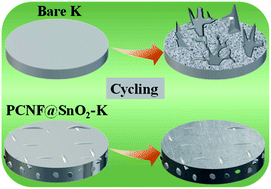Enhanced surface binding energy regulates uniform potassium deposition for stable potassium metal anodes†
Abstract
Dendritic growth is a major obstacle for the development of potassium metal anodes in K-ion batteries, which causes low coulombic efficiency, poor cycling stability and safety hazards. Herein, we report a 3D SnO2-coated conductive porous carbon nanofiber (PCNF) framework (PCNF@SnO2) as a host for K metal anodes. The SnO2 coating layer has a higher binding energy with K than with carbon and makes the PCNF framework highly potassiphilic, which regulates uniform K nucleation and deposition and suppresses dendritic growth. In addition, the interconnected 3D structure of the PCNF framework provides a large amount of void space and a robust structure to accommodate a large amount of K (87% @ 15 mg cm−2) and alleviate the stress/strain caused by volume expansion during plating/stripping. The PCNF@SnO2–K composite anode demonstrates an ultralong cycling stability of 1700 h at 1 mA cm−2, which is superior to those of other K metal anodes and even comparable with those of Li metal anodes reported in the literature. More importantly, enhanced performance is also achieved in a full cell using the composite K metal anode. Our results highlight a promising strategy for the development of stable and safe K metal anodes in KIBs.



 Please wait while we load your content...
Please wait while we load your content...